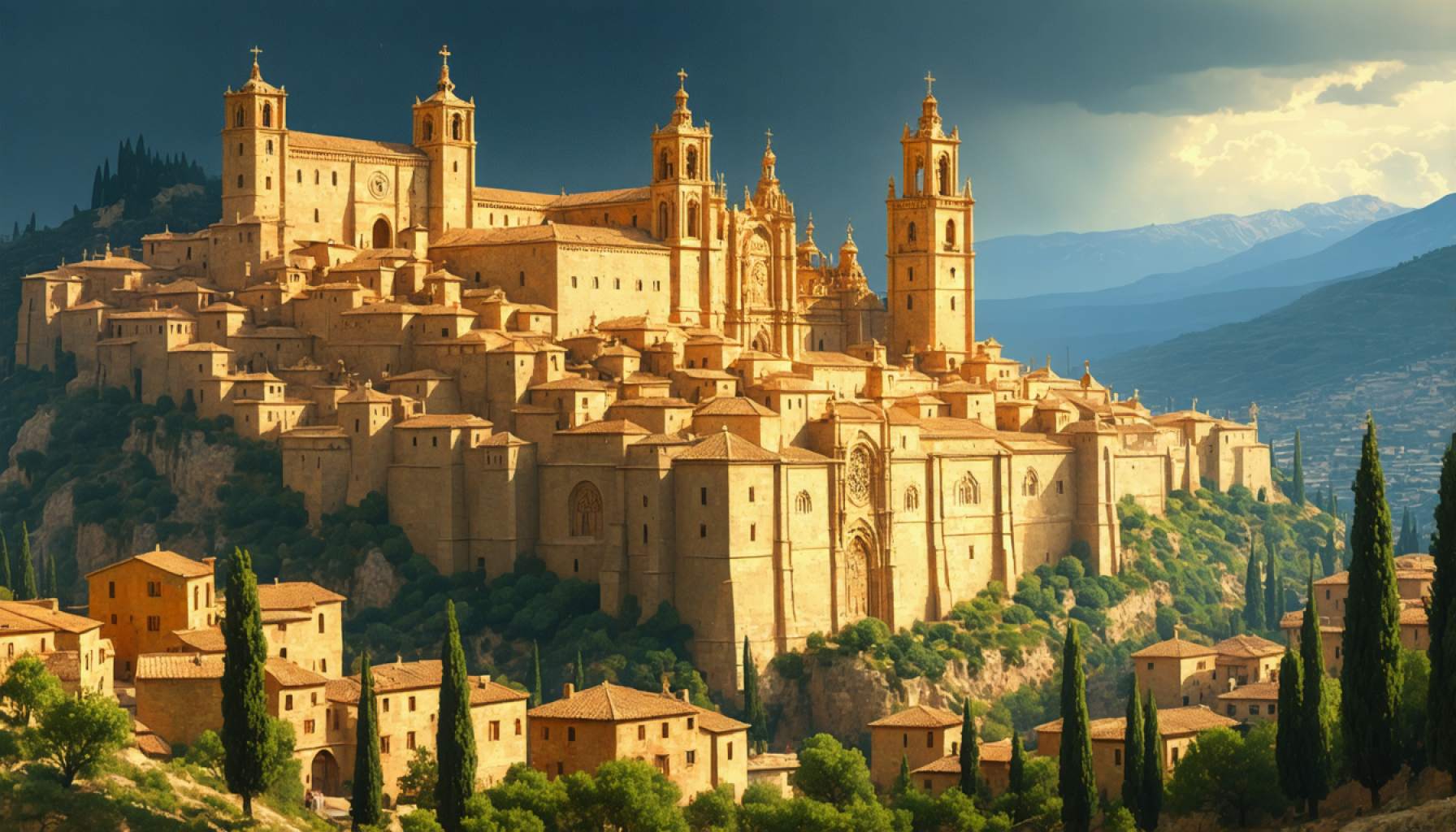
- The Caballos del Vino in Caravaca de la Cruz is a thrilling event featuring riders and adorned horses, attracting nearly 100,000 spectators annually and deeply rooted in local legend and tradition.
- Held in Murcia, the festival is part of the broader Fiestas de la Santísima y Vera Cruz, recognized by UNESCO for its cultural significance, combining medieval pageantry with Christian and pagan traditions.
- The event commemorates a medieval legend of the Knights Templar, who purportedly turned tainted water into wine during a Muslim siege.
- As a sacred pilgrimage site with historic significance, Caravaca de la Cruz is one of five cities sanctioned for perpetual jubilee years.
- Visitors can explore other attractions, such as the Basílica de la Vera Cruz, the Museum of the Wine Horses, and the scenic Fuentes del Marqués.
- Caravaca offers an immersive experience blending history, architecture, and vibrant cultural festivities.
As the vibrant crowd in Caravaca de la Cruz parts like a living zipper, an exhilarating scene unfolds that rivals even the famed passages of the Tour de France. However, instead of cyclists, majestic steeds adorned in dazzling regalia gallop through, led by spirited riders known as the caballistas. This is the heart-thumping spectacle of the Caballos del Vino, an event steeped in legend and bursting with tradition, drawing nearly 100,000 eager spectators annually to this quaint Spanish town.
Nestled atop a striking hill in the region of Murcia, Caravaca de la Cruz is a town where timeworn history and vibrant culture intertwine. Dominating the skyline is the grand Basílica de la Vera Cruz, a baroque masterpiece with roots that dig deep into the era of reconquest, centuries ago. The story birthed here during a Muslim siege in medieval times speaks of courage and mystique—a squadron of Knights Templar embarking on a rescue mission returned not with the desperately needed water, but with wine. As the legend goes, upon the precious liquid’s descent into the tainted reserves, it miraculously restored the purity of water, simultaneously healing the ailing besieged.
This historical tapestry weaves through the very fabric of present-day Caravaca, especially during the jubilant celebrations of the Fiestas de la Santísima y Vera Cruz. A cultural fusion declared an Intangible Cultural Heritage by UNESCO, these festivities shimmer with the allure of medieval pageantry. The climactic highlight, the Wine Horses Race, captures the imaginations as lavishly decked horses dash uphill with breathtaking speed—a vividly orchestrated replay of the templars’ legendary ride.
Yet, the celebrations are much more than high-octane races. They are a hypnotic blend of history and drama, commencing under the stars with a mesmerizing culinary competition of the region’s staple, Migas. This festival is deeply emblematic, a fusion of Christian and ancient pagan practices, serving as a beacon for locals and wanderers alike.
Caravaca’s charisma extends beyond the festival. A pilgrimage destination, it was sanctified as one of five holy cities capable of celebrating jubilee years perpetually, joining the ranks of such revered locales as Rome and Santiago de Compostela. Pilgrims have meandered along paths like the famed Camino de la Vera Cruz for centuries, covering vast distances to the chromatic crescendo of the Basílica.
But the allure doesn’t solely rest on spirituality. Nearby, the Iglesia de El Salvador invites with Renaissance artistry while the Museum of the Wine Horses offers an intricate glimpse into the lavish artistry of equine adornments. Meanwhile, the sandstone hues of the 19th-century neo-Mudejar bullring and the serene splendor of the Fuentes del Marqués provide scenic escapes into the verdant depths of the region’s storied past.
For those who embark on the journey to Caravaca de la Cruz, the town unfolds like a meticulously painted canvas of Spanish history and devout tradition. Its enchanting blend of myths, architecture, and communal revelries remain etched in memory, offering a resonant reminder of our enduring human saga woven through the looms of time.
Discover the Enchanting Tapestry of Caravaca: A Hidden Gem in Spain
Introduction: Unfolding the Magic of Caravaca de la Cruz
Nestled in the heart of Spain, Caravaca de la Cruz offers a spellbinding experience that combines history, spirituality, and culture in a vibrant tapestry. The town’s annual Caballos del Vino event, recognized by UNESCO as Intangible Cultural Heritage, showcases not only thrilling horse races but also centuries-old traditions that continue to echo today.
Facts and Features: Uncovering the Rich Layers of Caravaca
1. Historical Significance and Architecture:
– Caravaca de la Cruz is distinguished as one of only five holy cities in Christianity permitted to celebrate jubilee years in perpetuity. This honor emphasizes its importance in religious history, akin to cities such as Rome and Jerusalem.
– The Basílica de la Vera Cruz is a must-visit for history enthusiasts. This baroque structure stands as a testament to Spain’s architectural prowess during the era of the reconquest and shelters the revered fragment of the True Cross.
2. Cultural and Spiritual Experiences:
– Beyond the Caballos del Vino, Caravaca is known for its religious pilgrimages—the Camino de la Vera Cruz invites travelers to delve into a spiritual journey reminiscent of the more famous Camino de Santiago.
– Visitors during the Fiestas de la Santísima y Vera Cruz can enjoy culinary delights such as Migas, a hearty dish made from bread crumbs, garlic, and local ingredients, offering a taste of the region’s culinary heritage.
3. Art and Heritage:
– The Museum of the Wine Horses presents an intricate view of the equine adornments used during the festival, showcasing the artistic craftsmanship of the region.
– Nearby landmarks include the Renaissance-style Iglesia de El Salvador and the neo-Mudejar bullring, each providing insight into the area’s diverse historical influences.
How-To Experience the Best of Caravaca:
1. Planning Your Visit:
– Best Time to Visit: Aim for late April to early May to participate in the Caballos del Vino festival.
– Travel Tips: Consider using public transportation or car rentals. Regional trains and buses connect Murcia to Caravaca de la Cruz.
2. Maximizing Your Experience:
– Engage with Locals: Participate in local events beyond tourist attractions to truly immerse yourself in the culture.
– Explore the Surroundings: Venture out to the Fuentes del Marqués for a serene escape into nature’s bounty.
Market Forecasts & Industry Trends in Tourism:
As global travel trends shift towards experiential and cultural tourism, towns like Caravaca de la Cruz stand to gain significant interest. There’s an increasing demand for authentic travel experiences, predicting a robust influx of visitors seeking pilgrimage routes and unique cultural festivals.
Sustainability and Conscious Tourism:
As you plan your journey to Caravaca, consider practices such as supporting local businesses and minimizing waste to contribute positively to the community. This aligns with growing expectations for sustainable tourism, encouraging environmentally and socially conscious travel.
Conclusion: Tips for an Unforgettable Journey
– Embrace Spontaneity: While the festivals are scheduled, be open to discovering hidden gems and off-the-beaten-path trails.
– Respect Local Traditions: Understanding and honoring the cultural and religious significance of events enhances the travel experience.
For more information about visiting Spain and its hidden treasures, explore resources from spain.info, the official tourism website of Spain.
Embark on a journey to Caravaca de la Cruz, where the past and present dance in an enthralling celebration of life, legend, and spirituality. Each step in this sacred city invites you to rediscover the threads of humanity’s rich tapestry.



